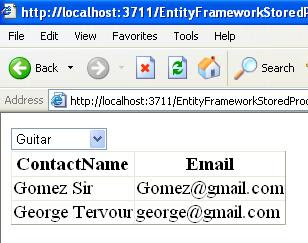using System.Data;
using System.Data.SqlClient;
using System.Configuration;
public partial class _Default : System.Web.UI.Page
{
SqlConnection cnn, cnn2;
SqlCommand cmd;
SqlDataReader dr;
protected void Page_Load(object sender, EventArgs e)
{
cnn = new SqlConnection("Integrated Security=sspi;Initial Catalog=master");
cnn.Open();
cmd = new SqlCommand("sp_helpDb", cnn);
dr = cmd.ExecuteReader();
TreeNode tn;
if (!IsPostBack)
{
while (dr.Read())
{
ddlDb.Items.Add(dr["name"].ToString());
tn = new TreeNode(dr["name"].ToString());
TreeView1.Nodes[0].ChildNodes.Add(tn);
}
dr.Close();
}
}
protected void btnExecute_Click(object sender, EventArgs e)
{
cnn2 = new SqlConnection(@"integrated Security=sspi;Initial Catalog=" + Session["Db"]);
cnn2.Open();
cmd = new SqlCommand(txtQuery.Text, cnn2);
dr = cmd.ExecuteReader();
GridView1.DataSource = dr;
DataBind();
dr.Close();
}
protected void ddlDb_SelectedIndexChanged(object sender, EventArgs e)
{
Session["Db"] = ddlDb.Text;
}
}
<%@ Page Language="C#" AutoEventWireup="true" CodeFile="Default.aspx.cs" Inherits="_Default" %>
<!DOCTYPE html PUBLIC "-//W3C//DTD XHTML 1.0 Transitional//EN" "http://www.w3.org/TR/xhtml1/DTD/xhtml1-transitional.dtd">
<html xmlns="http://www.w3.org/1999/xhtml">
<head runat="server">
<title></title>
<style type="text/css">
.style1
{
width: 100%;
}
</style>
</head>
<body>
<form id="form1" runat="server">
<div>
<table class="style1">
<tr>
<td colspan="2">
<br />
Select Database
<asp:DropDownList ID="ddlDb" runat="server" AutoPostBack="True" Height="21px"
onselectedindexchanged="ddlDb_SelectedIndexChanged" Width="122px">
</asp:DropDownList>
<asp:Button ID="btnExecute" runat="server" onclick="btnExecute_Click"
Text="Execute" />
<br />
</td>
</tr>
<tr>
<td>
<asp:TreeView ID="TreeView1" runat="server">
<Nodes>
<asp:TreeNode Text="Database" Value="Database"></asp:TreeNode>
</Nodes>
</asp:TreeView>
</td>
<td>
<table class="style1">
<tr>
<td>
<asp:TextBox ID="txtQuery" runat="server" Height="87px" TextMode="MultiLine"
Width="370px"></asp:TextBox>
</td>
</tr>
<tr>
<td>
<asp:TextBox ID="txtResult" runat="server" Height="16px" TextMode="MultiLine"
Visible="False" Width="370px"></asp:TextBox>
<br />
<asp:GridView ID="GridView1" runat="server">
</asp:GridView>
</tr>
</table>
</td>
</tr>
</table>
</div>
</form>
</body>
</html>










